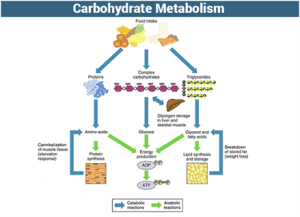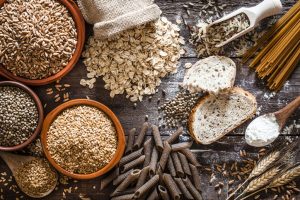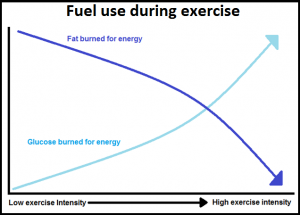Is Fasted or Non Fasted Training Better for Burning Fat and Building Lean Muscle?
Fasted Vs Non Fasted Training Basics: How Do Energy Systems Work?

During exercise, there are two primary sources of energy that get used. These are fats (triglycerides) and Carbohydrate (Glycogen and Glucose). There is also evidence that muscle and liver glycogen are essential for reducing fatigue and improving athletic performance (Figure 1).
Quick Summary: The Main Questions
When we exercise, the body naturally tends to use carbohydrate. This is because it breaks down more easily for energy. However, when our bodies are depleted of carbohydrates, fat is relied on for energy. This brings us to a key question: is fasted exercise better for breaking down fat? The intensity of exercise we do affects the rate our bodies break down fat and carbohydrate. This brings us to our second question. Would fasted resistance training have the same effect as fasted cardio?
How The Body Stores Carbohydrate
After eating carbohydrate the body breaks it down into glucose, fructose and galactose. This is then absorbed and used to provide energy. If there is an excess of glucose, then this stores as glycogen in the muscles and the liver. When these stores of glycogen are filled up, any remaining glucose is stored as fat.

Soit is essential to get the right amount of glycogen from your diet. This is because it is the body’s preferred energy source during exercise. It is crucial during short, intense bouts of exercise. For example, sprinting as well as weightlifting. This is because it is easily available. Glycogen also supplies your body with energy during the first few minutes of any sport. Therefore, would fasted cardio reduce performance?
Quick Summary: The Effects of Too Much and Too Little Carbohydrate
Consuming more carbohydrate than you need will result in excess body fat. On the flip side, our bodies need carbohydrates to carry out exercise to the best of our abilities. So depleting your carbohydrates will affect your performance. This is important to consider when deciding whether to train fasted or non fasted.
How the Body Stores Fat and Converts it to Energy
The body stores fat within the adipose tissue, in the form of triglycerides. These comprise of three fatty acids and a molecule of glycerol. There is a greater amount of energy (9kcal) in a gram of fat than in the same weight of CHO (4 kcal/g). In an average person’s adipose tissue, there are about 50,000 to 60,000 kcal stored as triglycerides. Therefore the body has the potential to store a large amount of energy in a small amount of mass. Because of this, it is an effective way of carrying energy.

Figure 2 shows the storage and mobilisation of the stored triglyceride. The triglycerides from the adipose tissue break down into glycerol. They also break down into free fatty acids (FFA). FFA mobilises by binding to plasma albumin (protein) for transportation. This goes to skeletal muscle and other tissues through the circulation. Intramuscular triglyceride also breaks down into fatty acids and glycerol during exercise. These enter the mitochondria for oxidation during exercise. Plasma triglyceride is another source of energy for muscles. However, its contribution to energy is minimal (Kiens et al., 1993).
Does the Body Use Carbohydrate or Fat for Energy?

The intensity of exercise influences the contribution of CHO and fat as an energy source. However, pre-exercise diet (or lack of) is another key influence. Next, I discuss the benefits of fasted or non fasted exercise in relation to the impact on training.
Quick Summary: The Body’s Preferred Ways to Break Down Energy
Fasted or Non Fasted Exercise
We have now established the basics of how our bodies deal with carbohydrates and fat. This brings us closer to the key question: is exercise when fasted or non fasted more effective?

Fasted Cardio
Compared with fasting, the ingestion of CHO in before cardio reduces fat oxidisation. This optimises the oxidation of fat after the workout (after-burn). Research also shows that consuming a high-fat diet reduces fat oxidation rates afterwards. This is due to both the decreased glycogen stores and adaptations at the muscle level. It is important to note that during endurance exercise, fat helps to fuel activity. But the body still needs glycogen to help break down the fat into something the muscles can use.
Fasted Resistance Training
Quick Summary: How Eating Before Training Affects After-burn and Performance
Compared with fasting, eating carbohydrate before cardio reduces fat burned during the workout. But, after you have finished working out, you will burn more fat throughout the day (after-burn). Eating high-fat foods before training will reduce the after-burn effect.

Therefore, it might be more a case of what to eat before training, rather than whether to train fasted or non fasted. Research shows similar effects for resistance training. But it might feel more difficult to train fasted than non fasted.
The Pros and Cons of Fasted Training
These pros and cons of fasted exercise should help you decide which is best for you.
Benefits of Fasted Exercise
- Improved fat burning: the body runs low on glycogen stores when fasted. This means the body will burn fat faster for energy. This increases fat burning, which increases weight loss.
- Easier digestion: eating before an exercise session can cause indigestion. Therefore fasted training will reduce digestive problems.
- Enhanced training adaptations: fasted exercise helps to improve endurance. This is through training the body to burn fat faster.
- Reduction in risk of metabolic disease: Research shows a potential reduction in symptoms. Examples are obesity and type 2 diabetes.
Drawbacks of Fasted Exercise
- Reduced workout performance: fasted training decreases the ability to maintain strength. It also compromises performance and leads to an increased risk of injury.
- Loss of muscle mass: fasted exercise increases the build-up of cortisol (stress hormone). This can burn amino acids (the building blocks of protein). You can avoid this breakdown of muscle by ingesting protein (e.g. a protein shake) half an hour before the workout.
- training in a fasted state results in reduced after-burn. After-burn is the energy burned after you have finished working out. Consuming CHO before a workout can increase the after-burn effect. This increases the overall calorie burn of your workout.
- Delayed workout: plasma glucose concentrations peak about 30-60 minutes after consuming CHO. If you’re training in a non fasted state, there needs to be an adequate amount of time between eating and exercise.
Increase The Breakdown of Fat Regardless of Fasted or Non Fasted Training
Fat converts into energy very slowly. However, it is possible to increase fat oxidisation through endurance training. This is regardless of training fasted or non fasted.

Firstly, the rates of fat oxidation differ between population groups. Trained individuals reach maximum rates of fat oxidation at exercise intensities between 59% and 64% of VO2max. In comparison, this is only between 47% and 52% of VO2max within the general population (Achten and Jeukendrup, 2004).
Secondly, the choice of exercise can also affect fat oxidation. It appears that fat oxidation is higher during running than cycling. With endurance training, there are a variety of adaptations. Some of these are more effective for fat burning than others.
Quick Summary: Other Ways to Increase Your Fat Burn
Well-trained endurance athletes have an increased capacity to oxidise fatty acids. There are also certain types of exercise that better suit fat burning. For example, running is more effective than cycling. Try shifting your focus from training fasted or non fasted to burn fat. It might be more a question of improving your cardiovascular fitness. It also might be more effective to think about the type of exercise you are doing. Different adaptations have different effects on burning.
Fasted or Non Fasted Exercise: Which is More Effective?
To summarise, below is a list of key points we have covered. This will help you decide whether fasted or non fasted training is more effective for you:
- At lower exercise intensities (45-65% VO2max), more fat oxidises.
- Ah higher exercise intensities (>65% VO2max), more CHO oxidises.
- Training fasted will allow the body to use more fat for energy.
- Training in a non fasted state will mean your body relies more heavily on CHO for energy.
- Fasted exercise improves fat burning. It is better for digestion and enhances training adaptation. It can also reduce the symptoms of metabolic diseases, such as obesity and type 2 diabetes.
- Non fasted exercise reduces workout performance. It can increase the breakdown of muscle mass. It also reduces exercise after-burn. Furthermore, it can delay your workout.
- Higher exercise intensities rely more heavily on CHO. Because of this, there may be a detrimental impact on performance when done in a fasted state.
- If you improve your cardiovascular fitness this will have an effect. You can then become better at using fat as an energy source.
- What suits you best should be the deciding factor of whether to train fasted or non fasted.
References
